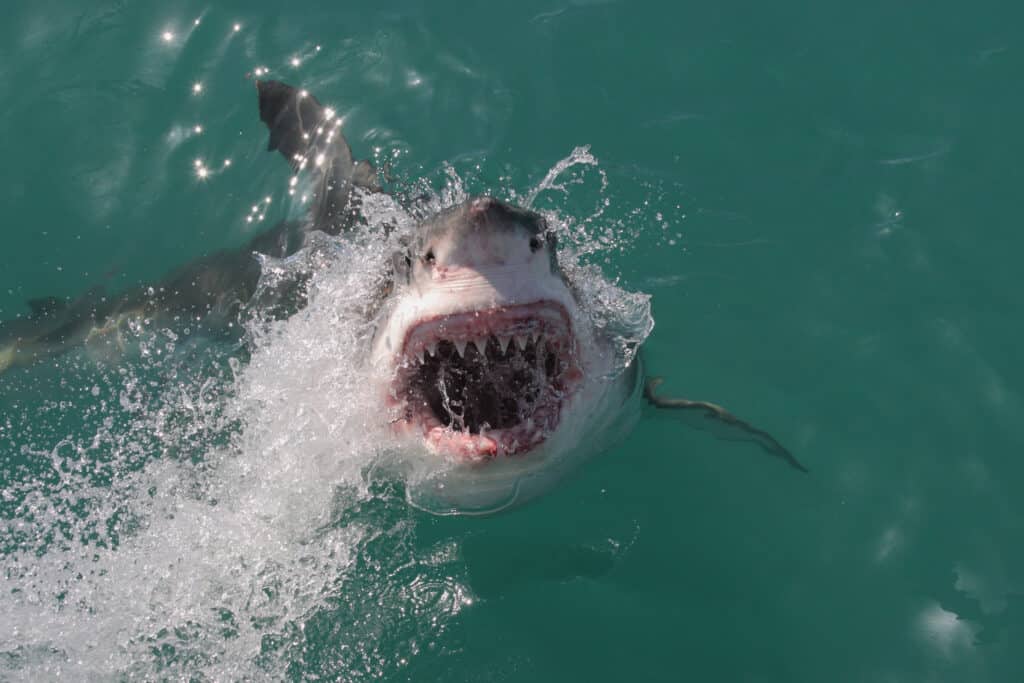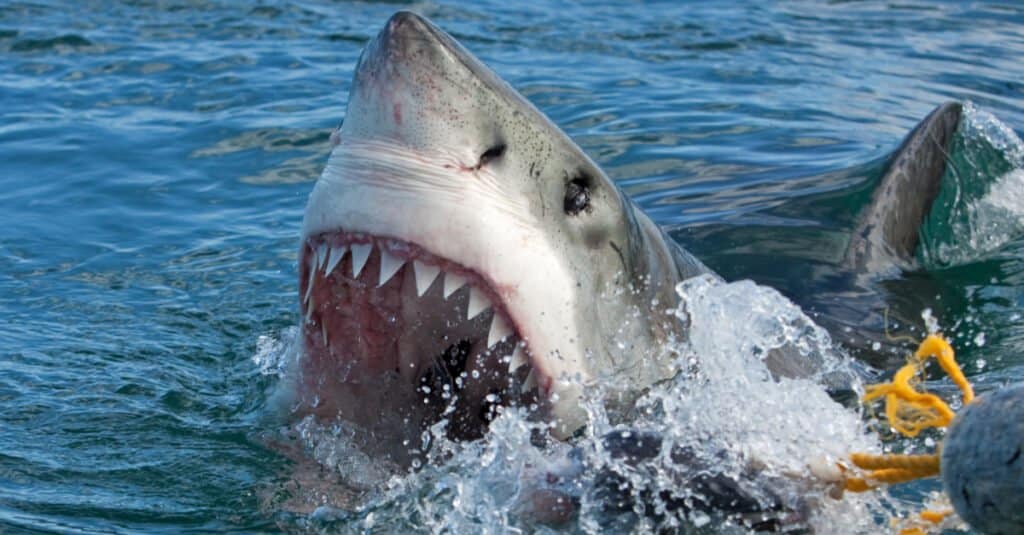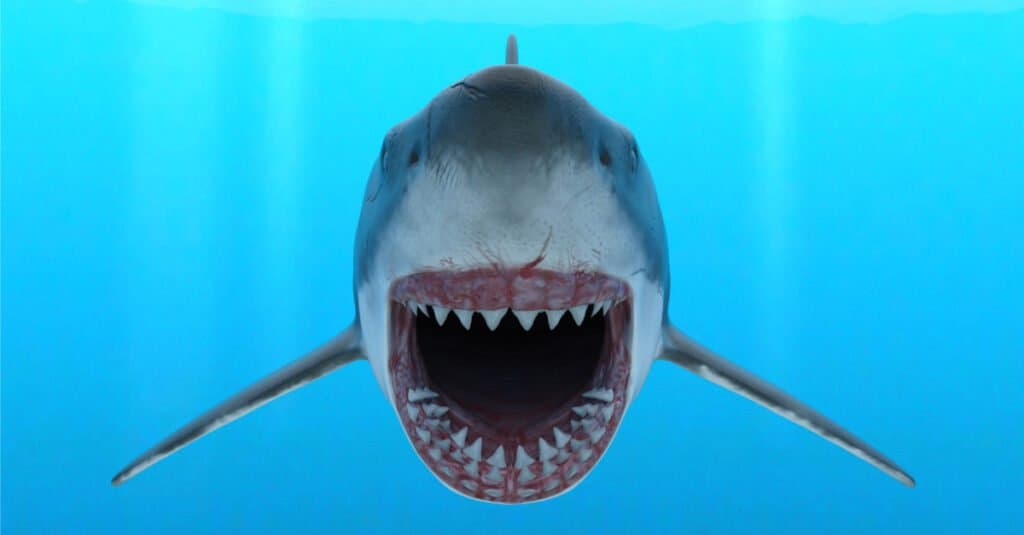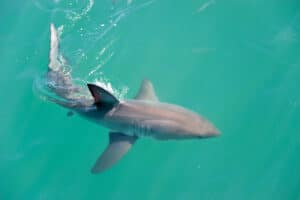The number of sharks in the United States has slowly increased since 1997 after the commercial and recreational harvesting of white sharks was restricted. Cape Cod, Massachusetts, is one of the country’s most “shark-infested” places. It is also a runner-up for the “shark attack capital of the world” title, especially since the shark detection rate has steadily risen over the past few years.
What are sharks?

Sharks are elasmobranch fishes that have been inhabiting Earth for more than 450 million years.
©Alessandro De Maddalena/Shutterstock.com
Sharks are elasmobranch fishes that have been inhabiting Earth for more than 450 million years! There are approximately 500 shark species grouped into 14-30 shark families. Some of the most common shark species are the great white shark, the cookiecutter shark, the tiger shark, the bull shark, the salmon shark, the nurse shark, and the horn shark. Incredibly enough, sharks are fish without bones. Their bodies are made of cartilage. Sharks live in many places but are most common around the United States and Australia, as well as in the Indian Ocean.
Sharks eat seals, dolphins, turtles, and other fish and sea mammals. Even though they’re considered one of the most dangerous fish species, sharks have predators too. Orca whales, also called killer whales, can easily feed on sharks. Sharks are also a food source for sperm whales.
Are there a lot of sharks in Cape Cod?
In 2014, the Massachusetts Division of Marine Fisheries conducted a study to count the regional shark population. The results showed that the number of sharks in Cape Cod had increased since 2013, when there were 10,803 sharks. In 2021, it reached 169,198, meaning 16 times more sharks than in 2013. If the rise was not very obvious between 2013-2015, the numbers started to move upwards in 2016, registering an approximate average of 15,000-20,000 shark detections. Scientists say they’ve even detected small sharks, which means they’re reproducing and rebuilding their population, so the numbers will continue to increase.
| Year | Shark detections |
|---|---|
| 2013 | 10,803 |
| 2014 | 18,602 |
| 2015 | 25,939 |
| 2016 | 51,679 |
| 2017 | 75,055 |
| 2018 | 111,528 |
| 2019 | 130,522 |
| 2020 | 136,135 |
| 2021 | 169,198 |
In 2021, the number of individual sharks spotted was 132, whereas, in 2013, it was only 11.
| Year | Individual shark detections |
|---|---|
| 2013 | 11 |
| 2014 | 22 |
| 2015 | 31 |
| 2016 | 38 |
| 2017 | 49 |
| 2018 | 63 |
| 2019 | 99 |
| 2020 | 117 |
| 2021 | 132 |
Which Cape Cod beaches have the most sharks?

Monomoy Island is home to numerous great white sharks.
©Martin Prochazkacz/Shutterstock.com
People have spotted sharks on numerous Cape Cod beaches. Monomoy Island, an 8-mile long piece of sandy land that’s sometimes connected to the mainland due to different water levels, is home to numerous great white sharks. As for the beaches, according to 2019 data, Nauset Beach registered the biggest number of shark sightings – 43. The second on the list is the Chatham Peninsula, with 27 shark detections, followed by the Head of Meadow Beach, with 16 detections. Let’s see what other Cape Cod places “hosted” sharks in 2019 and how many there were.
| Rank | Beach | Shark detection |
|---|---|---|
| 1 | Nauset Beach | 43 |
| 2 | Chatham Peninsula | 27 |
| 3 | Head of Meadow Beach | 16 |
| 4 | Newcomb Hollow Beach | 13 |
| 5 | Aunt Lydias Cove Park | 12 |
| 6 | Race Point Beach | 12 |
| 7 | Coast Guard Beach, Truro | 10 |
| 8 | Long Nook Beach | 8 |
| 9 | Marconi Beach | 7 |
| 10 | Ballston Beach | 6 |
| 11 | North Truro High Head Beach | 5 |
| 12 | Coast Guard Beach, Eastham | 4 |
| 13 | White Crest Beach | 3 |
| 14 | Plymouth Beach | 3 |
| 15 | Duxbury Beach | 3 |
| 16 | Nauset Beach Lighthouse | 2 |
| 17 | Nantucket | 2 |
| 18 | Long Beach | 2 |
| 19 | Cahoon Hollow Beach | 2 |
| 20 | South Beach Martha’s Vineyard | 1 |
| 21 | Plum Island | 1 |
| 22 | Breakwater Beach | 1 |
| 23 | Barnstable Harbor | 1 |
What types of sharks can be found on Cape Cod?
The most common shark found on Cape Cod is the great white shark. It is considered the most dangerous and aggressive shark species worldwide. Great white sharks have attacked 333 people, and 52 of them died. These have been spotted in Cape Cod in high numbers from May to November.
Here are other types of sharks that can be found on Cape Cod:
- Basking Sharks;
- Blue Sharks;
- Shortfin Mako Sharks;
- Sand Tiger Shark;
- Spiny Dogfish;
- Porbeagle Sharks;
- Thresher Shark;
- Dusky Shark;
- Hammerhead Shark.
What are the chances of getting bitten by a shark in Cape Cod?

The risk of getting bitten by a shark in Cape Cod is high.
©iStock.com/BWFolsom
If you venture deep into the ocean, the risk of getting bitten by a shark in Cape Cod is high. Sharks usually spend their time at a 15-foot depth. However, a Stanford University study shows that the chances of being bitten by a shark are meager–one in a billion, to be precise. Even though shark bites do occur, the risk of fatal bites is low.
The last fatal shark attack on Cape Cod happened in 2018. Before that, the last fatal shark bite occurred in 1936. The tragic 2018 event happened at Newcomb Hollow Beach in Wellfleet, Massachusetts. This death has deeply shaken the Cape Cod population. People have seriously started to wonder how to solve the shark problem.
However, if we were to decide based on data, the chances of drowning from riptides are much higher than being bitten by a shark. Over five years, 680 people were rescued from drowning in riptides.
Why are there so many sharks in Cape Cod now?
The number of sharks off Cape Cod has dramatically increased over the past years. But why? Why are these waters so full of them? What attracts them here?
One of the reasons could be the restrictions put on April 3, 1997, by the Federal Government regarding shark fishing. The government applied the restrictions from the North Atlantic to the Gulf of Mexico. People usually catch sharks for their meat, skin, fins, and the oil in their liver. The number of shark catches has significantly dropped since 1997. This probably influenced the shark “infestation” in Cape Cod and other U. S. regions.
Another thing associated with the high number of sharks in United States waters, including those of Cape Cod, is that seals became federally protected by the U.S. Marine Mammal Protection Act when they were almost extinct. Their population has become larger, and so has the sharks’ population because seals represent a significant food source for sharks.
The photo featured at the top of this post is © Alessandro De Maddalena/Shutterstock.com
Thank you for reading! Have some feedback for us? Contact the AZ Animals editorial team.







